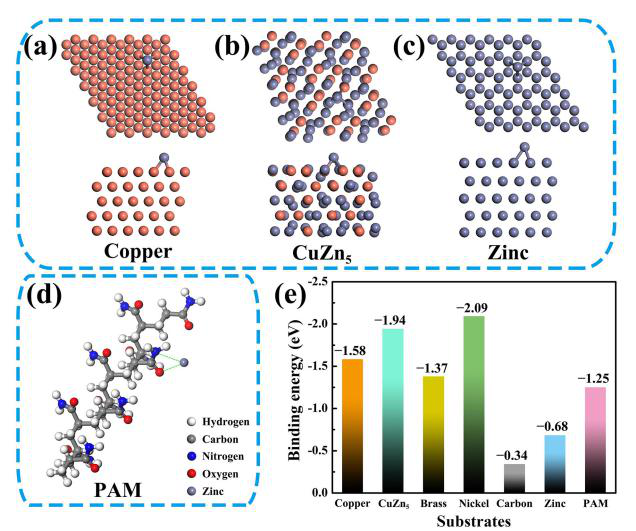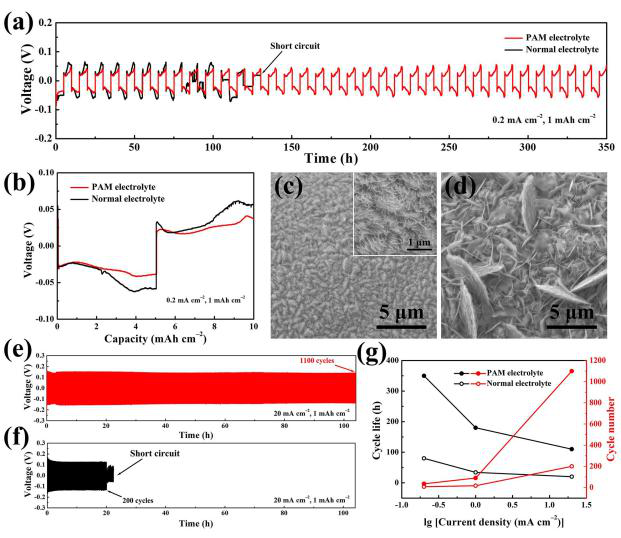The latest research achievement about zinc energy interface control reached by Tang Yougen-Wang Haiyan Team from the College of Chemistry and Chemical Engineering, Central South University (CSU) has been published onAngew. Chem. Int. Ed.(IF=12.1), an international top-level periodical in chemical field, and selected as the cover article. The title of thesis is “Insights into Three-dimensional Dendrite-free Zinc Anode on Copper Mesh with Zinc-oriented Polyacrylamide Electrolyte Additive” (DOI: 10.1002/anie.201907830)”. This paper has been completed under the joint instruction of Associate Professor Wang Haiyan and Professor Tang Yougen, with CSU as the first unit, Associate Professor Wang Haiyan as the corresponding author and Doctor Zhang Qi in grade 2017 as the first author.

Lithium ion battery, with the advantages of high energy density and long cycle life, has been widely used in portable sets and electric automobiles. However, rising costs of raw materials and safety problems caused by flammable organic electrolyte have restricted further development. Metallic energies such as zinc and aluminum with high energy have the advantages of high energy density, rich resource and low cost and may constitute various battery systems; for example, aqueous zinc ion battery characterized by high natural abundance and ionic conductivity is considered as the low- cost and high-safety energy storage systems which may replace lithium ion battery and have received extensive attention in recent years. Similar to lithium anode, the formation of zinc dendrite may result in problems such as poor cycling stability and low coulombic efficiency, which seriously restrict the practical application of zinc anode.


(DFT theories calculation model VS. symmetrical battery in cycle performance)
Based on the conditions above mentioned, the team has proposed a synergetic modification strategy to prepare dendrite-free zinc anode on copper mesh with zinc-oriented polyacrylamide (PAM) electrolyte additive. The cooper mesh may not only provide structural support for zinc anode but also facilitate even nucleation of zinc through Cu-Zn solid solution from in-situ formation; the acyl on PAM has strong selective absorption to zinc ion which may evenly distribute on the surface of electrode along the transfer of polymer chain. The DFT calculation proves the positive role of Cu-Zn solid solution and PAM to zinc deposition. The prepared zinc anode presents dendrite-free morphology in wide range of electric current density (0.2-20 mA cm-2) and could utilize the activation interface of PAM after modification to significantly improve the cycling stability. The prepared zinc anode may stably cycle for 280h in symmetrical battery at a discharge capacity of 4 mAh cm−2(depth of discharge= 80%) with low lagging voltage and significantly improved electrochemical performance. The assembled Zn/MnO2battery may cycle 600 times under the electric current density of 1 A g−1.
The works above mentioned have won the supports from the funds and talent projects such as National Natural Science Foundation of China (S/N: 21671200, 21571189), Hunan Province Science and Technology Plan Projects (2017TP1001), Hunan Province Science and Technology Major Special Projects (2017GK1040), Hunan Province Young Talents and CSU “Shenghua Yuying Plan”, etc.
Source: College of Chemistry and Chemical Engineering











